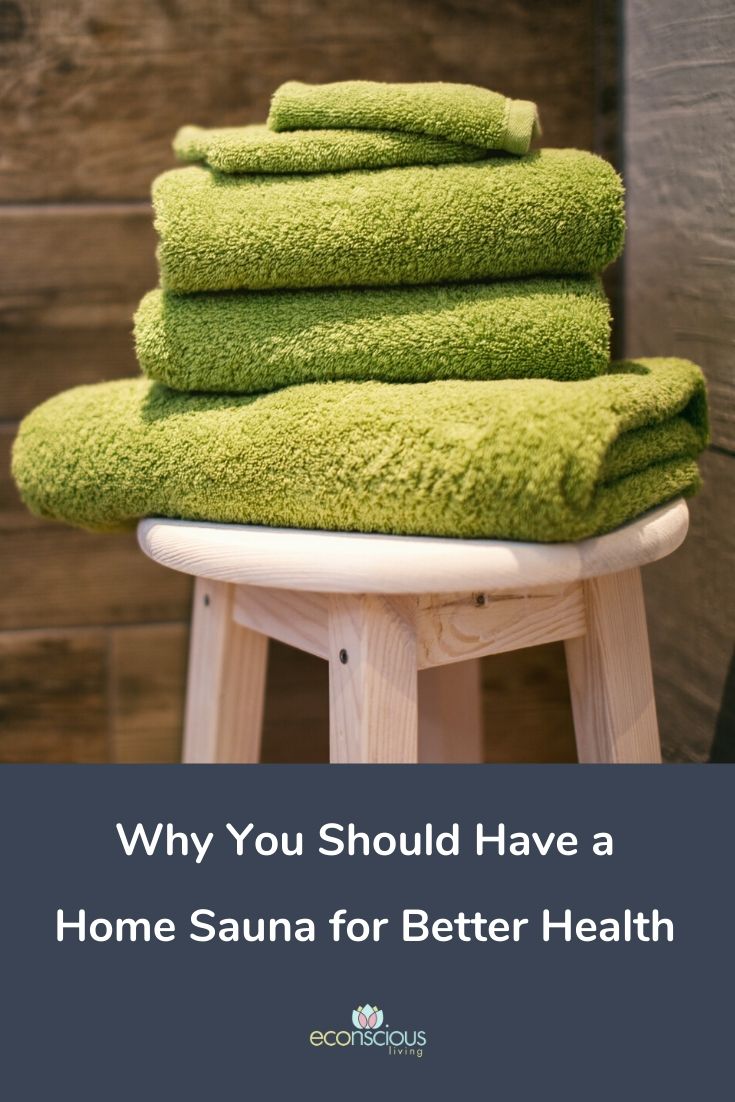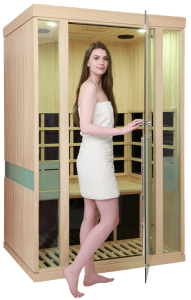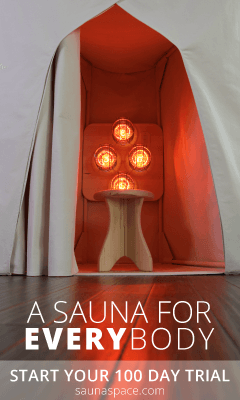Why You Should Have a Home Sauna for Better Health
The information in this article is only the opinion of the author and is for educational purposes only. It is not for the diagnosis, treatment, prescription or cure of any disease or health condition.
Update: Since this blog post was originally published I have purchased my own fabulous sauna. Scroll to the bottom to find out which one I selected after years of research. Once I found it, I just knew it was the one!
Twenty years ago, not long after moving to sunny Perth from Ireland we were looking at homes to buy. One of them had a home sauna. I thought “why in the world would you want a sauna in a place as hot as Perth?” Crazy!
Well, after spending hours researching the health benefits of saunas, I now get it. Quite simply if there was a pill that did ALL the things that research is showing us saunas do, you would be taking it.
Given I’m on the hunt for a home sauna myself, I thought it would be nice to share my thoughts and findings with you all.
Saunas come in all shapes and sizes. If like me you’ve been bedazzled by all the options but want to make a great long-term investment in your health and get it right first time then we are on the same page. Read on or jump to a section below!
- Saunas and our health
- Different types of saunas
- Are infrared saunas better than traditional saunas?
- Research on saunas
- Benefits of a home sauna
- What is the best temperature and duration?
- What’s the difference between red light therapy and infrared saunas?
- How do you know which sauna to buy?
- Considerations when buying a healthy home sauna
- My home sauna recommendations
Saunas and our health
The list is long when it comes to all the modern ailments and diseases that saunas can dramatically help with: energy levels, autoimmune disease, dementia, ageing, weight gain, arthritis, heavy metals and chemicals detoxification, high blood pressure, heart attacks and disease, anxiety, depression, mood, focus and attention, chronic fatigue, athletic performance and recovery, muscle loss…
It’s very clear, and quite frankly depressing, that whilst our lifespans have increased the quality of them sure as hell hasn’t.
I, like many health experts believe much of this is due to the toxic environment we inhabit in our homes and workplaces, be it indoors or outdoors.
I teach people how to clean up their living and work environments but how do you clean up the excess that which we can’t control?
The answer is saunas.
I’ll explain how in just a bit but first let’s look at the different types of home saunas. Understanding the difference between the two is really useful when it comes to working out which sauna will suit you or your family the best.
Different types of saunas
There are two main types of saunas:
1. Dry or wet (Finnish) saunas
A radiant electric or ceramic heater is usually the main source of heat. The heater heats the surrounding air and this then transfers to your body.
A sauna is referred to as ‘dry’ when the humidity is less than 20%. But in Finland it is customary to chuck water over hot coals to increase the humidity to 50% or more; hence, the ‘wet’ sauna.
Dry saunas are considered more tolerable than wet. In Finland, they will often alternate 2-3 sauna sessions with cold water immersions in a shower, pool or even a good ole’ roll around in the snow! Dry or wet saunas start at about 70oC and reach temperatures of about 100oC. They are usually used for between 5 and 20 minutes.
2. Infrared saunas
This sauna uses different parts of the infrared spectrum to increase your core body temperature directly, and so in contrast to the traditional sauna, the air is only minimally heated. Most infrared saunas only use far-infrared wavelengths, some use only near-infrared, and others use full-spectrum infrared light (near, mid and far).
The key differences between an infrared and a traditional sauna are the temperature and the source of the heat.
Infrared saunas use a variety of heat sources, for example, incandescent bulbs, LEDs, halogen bulbs or carbon heaters. These heat up to about 60oC and are usually used for 45 minutes to one hour. The highest temperature I’ve experienced is 70oC. Temperature is important when it comes to the health benefits so I’ll come back to this later.
You may also have heard of Waon therapy which is a dry far-infrared sauna therapy used in Japan for experimental purposes.
Waon means ‘soothing warmth’ in Japanese. The dry sauna is kept at 60℃. Waon therapy warms the entire body in a uniformly heated chamber for 15 minutes and then maintains the soothing effect outside the sauna for another 30 minutes. This type of infrared sauna therapy has been the subject of many studies particularly relating to cardiovascular effects.
Are infrared saunas better than traditional saunas?
Just as our food contains various vitamins and minerals which serve different functions in the body, bestowing us with lots of health benefits, the same applies to light.
Different frequencies of infrared light (far, mid, near) provide different benefits to the body.
Despite the fact that infrared saunas are all the rage in the health and fitness scene right now, I don’t think most people really understand why. To understand more, let’s first take a step back and look at light more generally.
Visible light is made up of all the colours of the rainbow including red light. Infrared light is invisible and lies just beyond the red end of the EMF spectrum. It makes up 42% of sunlight. It is composed of three distinct infrared types depending on where it is located on the spectrum: near-infrared, mid-infrared and far-infrared.
Whilst far infrared is really good at heating the surface of the skin and making you sweat a lot, the near-infrared wavelengths penetrate the body deeper into the tissues and organs (brain, heart, reproductive organs) up to 3 inches in some cases.
Pin it for later!

With near infrared you heat up from the core and this is where the magic happens as the heat acts to improve your mitochondrial function deep within the body.
This is the crux of the surge in all things infrared in the holistic health scene right now: the impact on your mitochondria.
Your mitochondria drive pretty much every function in your body from your mood to your heartbeat.
Mitochondrial disease (not genetic) is understood to be at the core of most our modern-day illnesses.
Traditional saunas on the other hand heat the air around you to much higher temperatures than infrared and the heat is then transferred to your body. You get very hot, very quickly. Most people find them much less tolerable than infrared saunas. But what does that all translate to in health benefits of either type of sauna?
What does the research tell us? Which sauna is best?
Research on saunas
The statistics on the health benefits of using a sauna are really quite staggering. The studies from which these statistics are derived include long-term prospective population studies along with experimental, mechanistic and animal studies.
Most of the research on saunas to date has been done on traditional saunas and not so much infrared simply because they have been around for a much longer period of time.
The most well-known sauna research comes from the Kuopio Ischemic Heart Disease Risk Factor (KIHD) Study which began back in 1984. Still ongoing, it’s assessing the health outcomes in more than 2300 middle-aged (42-60yo) Finnish men and women from traditional sauna use.
The study has yielded close to 500 international, peer-reviewed original articles and more than 20 PhD theses.
The study is impressive because of its long duration (20 plus years) but also because it controls for so many factors: age, exercise, diet, smoking, lifestyle etc. One of the most prominent of the KIHD researchers studying the links between sauna use and health effects is that of cardiologist and PhD scientist Dr Jari A. Laukkanen who has published many peer-reviewed studies on the topic.
As I will discuss further below, his studies identified strong links between sauna use and reduced death and disease. Some other studies on the health benefits of infrared saunas have come from Japan and Korea where Wuon therapy is being used as described earlier.
There is also much we are learning from tiny worms and flies on heat therapy!
Even though we may seem a world apart in the evolutionary process they actually have some similar longevity genes to humans. The findings from these animal studies are in line with those in humans, demonstrating a clear improvement in life-span as a result of heat therapy.
These studies and others are linked at the end of this blog.
Benefits of a home sauna based on the literature
The benefits you can get from a sauna are far-reaching. The list is so long that I’m not even going to mention them all but here is a summary of just a few.
If you know all this already and you want to cut to the chase and skip the many hours of research I’ve put into this blog then scroll to the end for my go-to home sauna recommendations.
1. Improves your mitochondrial function
There’s plenty of research showing that between the ages of 40 and 70 we lose about half of our mitochondrial capacity. Indeed, by the age of 70, we have usually obliterated about 75% of our mitochondria.
Mitochondrial disease is at the heart of most of our modern-age diseases and it’s what causes us to age more than anything. But exposure to extreme heat (and/or cold) activates the creation of new mitochondria also called mitochondrial biogenesis.
2. Detoxification
Detoxification of heavy metals is one of the main reasons people initially jump on the sauna bandwagon.
With heat stress, blood flow is diverted to the surface of the skin releasing toxicants as well as sodium and nitrogen through your sweat. Most people will lose ~0.5kg of sweat in a sauna session.
A huge bonus is that saunas remove both fat-loving (lipophilic) and water-loving toxicants (hydrophilic) and both persistent (phthalates, BPA) and non-persistent pollutants (PCB, DDT).
Saunas have also been shown to improve liver detoxification pathways.
Research shows that hard to remove toxic heavy metals such as aluminium, cadmium, cobalt and lead are way more likely to be excreted through your sweat than your urine.
Other environmental toxicants that have also been shown to reduce with sauna use include BPA, phthalates, PCBs, fluoride, solvents, PFCs (fire-fighting foam and non-stick cookware), methamphetamines, flame retardants, hexachlorobenzene (fungicide common on wheat) and organochlorines (DDT).
BPA, an endocrine disruptor, is found in lots of our plastics and tin linings. PCBs and DDT were both banned years ago, yet still persist in the environment and find their way into our food and bodies. Phthalates are used to soften plastics (e.g. PVC) and to fragrance just about everything. This detoxification process has also been shown to improve symptoms of multiple chemical sensitivity which many of my clients also suffer from.
On a similar note, sauna therapy helped many of the rescue workers suffering from toxic loads post-911 World Trade Centre attack when nothing else did.
3. Increases your lifespan via heat stress
The aforementioned KIHD study (2300 middle-aged men studied over 20 years) found this:
- Men using a Finnish sauna 2-3 times a week were 24% less likely to die from ANY cause of death (all-cause mortality) compared to those using it just once a week. Impressive, hey?
- But even more impressive – those using it 4-7 times a week were 40% less likely to die from any cause of death.
Heat shock response is the key mechanism by which this effect occurs.
Heat stress activates heat shock proteins (HSP) and a ‘longevity’ gene called FOX03. These heat shock proteins (HSP) help to mop up the damage we create in our cells on a daily basis especially in toxic environments. The HSP repair damaged and dysfunctional proteins, which are considered central to our modern-day diseases such as Alzheimer’s disease, Parkinson’s disease and cardiovascular disease.
Studies show that just 30 minutes of sauna use at 73oC significantly increases heat shock proteins.
Another study of over six days of consecutive sauna use, showed similar effects corresponding to a 28% increase in mitochondrial function.
The aforementioned FOX03 longevity gene plays a crucial role in controlling tumours (cancer) and repairing DNA damage.
4. Increases weight loss
Sauna use appears to modulate appetite whether you have appetite loss or increased appetite leading to obesity, as it seems to regulate the hunger hormone called ghrelin. Other studies show that those using saunas and exercising versus those exercising alone had much greater weight loss. It has also been shown to increase your metabolic rate.
5. Improves your mood
Sauna use increases brain-derived neurotrophic factor (BDNF) which increases the growth of new brain cells. This is possibly the reason sauna use is linked to reduced depression and chronic fatigue.
6. Improves your cognitive ability
This is believed to occur because of improved blood flow both to the brain and peripheral nervous system.
Again, the KIDH Finish study showed that men using the sauna four to seven times a week had a 65% reduced risk of developing Alzheimer’s disease compared to those who used it just once a week.
Similarly, the risk of getting dementia was reduced by 66%. We all know that Alzheimer’s disease and dementia are escalating at a scary rate. The question is will you act to do something about this dreaded disease now before it’s too late?
7. Improves your cardiovascular function
Again, the Finnish KIHD study has shown that men who use saunas 2-3 times a week are 27% less likely to die from heart-related diseases.
Those using the sauna 4-7 times a week are 50% less likely to die from heart-related disease.
The Waon therapy (infrared) studies from Japan showed that just two weeks of therapy improved the outcomes from 149 patients with congestive heart failure compared to those with standard medical care. Similar positive outcomes were experienced by patients given Waon Therapy over 2-3 week periods with coronary heart disease, peripheral heart disease and premature ventricular contractions.
Many studies have also shown regular sauna use to reduce hypertension (high blood pressure) commonly associated with heart problems.
8. Enhances recovery after exercise and athletic endurance
Sauna use is very popular among professional and amateur athletes. It reduces lactic acid build-up after exercise and reduces muscle soreness and damage allowing a quicker post-workout recovery.
9. Increases muscle growth
Saunas have been shown to increase muscle growth and slow muscle loss. It does this by increasing growth hormone levels.
The results vary depending on the temperature and duration of the sauna use. Shorter but hotter (15 minutes at 100oC) sauna sessions give better results than longer and cooler (20minutes and 80oC) sessions.
Given we lose 10% of muscle mass every decade after we turn 40 this is a great way to maintain muscle mass especially if you are not keen on strength training. But research shows that when you combine the synergistic effects of exercise and sauna together the results are even better.
10. Better skin health
I’m yet to see someone who uses a sauna and doesn’t have glowing skin health. All that detoxification pays off big time!
Saunas have also been shown to help with psoriasis and acne. It does so by reducing oil, increasing hydration and regulating the skin’s pH.
11. Improves your immune system
Heat stress using a sauna just once or twice a week for three months has been shown to reduce the incidence of the common cold. Pneumonia risk was also reduced by a whooping 40%. Of course you won’t find a specific sauna study relating to COVID-19 but I do know that some of the world’s top doctors are recommending saunas or even hot baths to boost your immunity against the virus.
What is the best temperature and duration?
Now as you can read in my points above, the dose is really important when it comes to health benefits.
What temperature is the sauna and for how long are you using it?
Twenty minutes in an infrared sauna is not the same as twenty minutes in a traditional sauna because one is much hotter than the other.
Many of the studies I mention above show incredible health benefits at temperatures greater than 70oC.
These high temperatures can only be obtained in a traditional dry or wet sauna, not an infrared sauna. The KIHD studies show that a minimum of 20 minutes duration at 78.9oC plus (174oF) is the optimal dose for health benefits in a Finnish sauna. A duration of 20 minutes or more is a lot more beneficial than 11 to 18 minutes.
Does it mean there aren’t any benefits from an infrared sauna because it’s that bit cooler (60-65C usually)?
No, it’s just that we don’t have the long-term data that we have for Finnish saunas, mostly as a result of the KIHD study.
Having said that, Waon therapy (infrared sauna) studies show highly impressive cardiovascular health benefits. But no one has done a comparison between dry/wet sauna and infrared saunas to see which is better so the jury really is out on that.
It also has to be noted that even though near infrared or full spectrum saunas don’t get as hot, because the near infrared wavelengths penetrate much deeper into body you still get very hot from deep within the core very fast. They are plenty hot for me even at 65oC!
What’s the difference between red light therapy and infrared saunas?
This confused me for a long time and I will leave the detail for another day. But in summary, saunas (including infrared saunas) and red light therapy (photobiomodulation) are considered two different modalities.
Simply put, the former is considered heat therapy whereas the latter is considered light therapy.
The effects from red light therapy (photo-biomodulation) are incredible but they are different and not many saunas combine both heat and light therapy well, if at all.
Red light devices use very specific red and infrared light frequencies between 600 and 1000nm to stimulate your mitochondria (cytochrome C oxidase) to bring wide-ranging health benefits to your body.
Red light devices generally use LEDs but some use incandescent lights. By the end of a 10- minute red light therapy session, you will feel cosy and warm but the aim is not to make you sweat but to improve your mitochondrial function using light.
In my view, if you want red light therapy you need to buy a red light. Now many prudent biohackers to save time will transfer their red light into the sauna killing two birds with one stone and getting their heat and light therapy at the same time. This is not officially recommended by the sauna manufacturers, of course! It may also be the case that all that sweat is reducing the beneficial effect of the near infrared light component.
Although saunas and red light therapy don’t usually come as one package the SaunaSpace is different.
The SaunaSpace full spectrum sauna brings you the heating benefits of a sauna but its design is such that it also provides red light therapy (photobiomodulation).
It can do this because it uses full-spectrum incandescent light bulbs (not LEDs) at specific wavelengths and intensity.
How do you know which sauna to buy?
Well, before you buy try different styles out at various temperatures.
Hop in an infrared sauna and observe!
Do you generate rivers of sweat within minutes of getting in, and start to feel uncomfortable? Because the health benefits are in this discomfort. This is what makes those mitochondria and every cell in your body sing. And this is one of the key reasons why infrared saunas are so popular, unlike dry/wet Finnish style saunas users can tolerate them much better.
Of course, regardless of the type of sauna you use you always need to acclimatise to the heat, starting off with lower temperatures and short durations and gradually building it up.
Considerations when buying a healthy home sauna
Sauna materials
Most saunas are built using wood such as cedar, spruce, pine or basswood but we are also seeing an emergence in portable saunas made mostly from synthetic material and less so natural fibres.
The material used to make a sauna is important because many of the cheaper saunas will not source sustainable natural woods or use no/low VOC glues.
They will frequently use man-made fibres and glues that off-gas nasty VOCs including the carcinogen formaldehyde. Everything off-gasses much quicker when it is heated so combining toxic glues and synthetic wood in a sauna is not smart for your health.
It’s actually counter to much of what you are trying to achieve by using a sauna in the first place – detoxification. Think long and hard before you fork out for a cheap sauna online.
A note on cedar, that lovely warm traditional material of choice for saunas. There are some people who don’t tolerate cedar well at all. If you suffer with a sensitivity to chemicals, fragrances, mould etc this might be a clue that you should trial a cedar sauna before you order.
There are some equally sustainable alternatives to cedar such as Basswood, as well as natural cotton canvas.
EMF and flicker
Some of you won’t care for this but because I want to achieve optimal health it’s at the forefront of my decision-making when it comes to buying a sauna.
Most saunas have very high levels of EMF.
If you use Bluetooth in your sauna, sorry, it’s high EMF.
If you use WiFi in your home or in the health spa you visit for sessions, it’s also high EMF.
Frankly, if you don’t care about your WiFi or your mobile phone use there is no point in worrying about EMF in your sauna. You have bigger fish to fry. Start by cleaning up your living or work environment first.
But I digress, those of us looking for an optimal sauna? Here are my EMF pointers:
- Ask if the Bluetooth can be disabled and if it has an auxillary cable connection instead.
- Ask if the sauna has shielded electrical wiring to reduce the electrical fields.
- If both one and two check out, then ask if they have measurements for the AC magnetic, electrical fields and body voltage readings. Now 99% of sauna brands will fail on this. The most common response you will get is “yes, it has low levels of EMF that are less than 3mG”. If this is the answer you get it is a clear indication that the manufacturer has NO clue about EMF, move on elsewhere. A measurement of 3mG refers to AC magnetic fields but safe levels need to be less than 1mG (not 3mG)! As for body voltage and electric field measurements good luck getting that information from them. The only good information I usually see is from EMF consultants who independently test these saunas in their spare time.
- Flicker – again not usually a health consideration by sauna companies because those that use LED lights (including any sort of chromotherapy) by default flicker a lot. Saunas that use incandescent lights have much lower flicker and are, as such, healthier. (Tip: If you use chromotherapy only use the red light setting after sunset).
- Another tip to reduce your EMF exposure is to go smaller. A one or two person sauna will generally have much lower EMF than larger models as the electrical requirements increase with the number and power of the heaters.
How healthy and fit are you?
Infrared saunas operate at lower temperatures (most around 60-65oC) and are therefore better suited to those not in optimal health.
The hotter Finnish saunas should absolutely be considered if you are fit, healthy and into athletic performance. There is so much research supporting their wide-ranging benefits you’d be a fool not to give them ago.
Many hard-core athletes will alternate between the Finnish and infrared saunas.
The general consensus is that if you don’t get the sauna hot enough to cause you to discomfort it’s not optimal for you. So try before you buy.
Question those sales pitches
Full-spectrum infrared saunas are sometimes spruiked as being better for detoxification than Finnish saunas because of their deeper penetration into the body which apparently leads to more sweating.
Whilst this may be true (I certainly start sweating very fast in a full spectrum sauna) I have not seen any research to prove this. As mentioned previously, I’ve also not seen any research comparing the two types of saunas.
Portability
I love the idea of having a portable sauna so that when you move home you can easily take it with you.
However, having looked into some of those independently tested for EMF, including some well-respected ‘low-EMF brands’ I’m not won over. Their EMF levels are simply too high for me because the ‘sleeping-bag’ or sauna cover is so close to you, and the electric fields and hence your body voltage, is way too high.
When it comes to all forms of EMF, distance is your number one friend.
However, some of the portable tent-like saunas are great which I’ll discuss below.
You also want to check the toxicity of the material used in these saunas as many are made from synthetic materials which off-gas. If you are keen on the tent type saunas then trial to make sure you can maintain a high temperature within the enclosure that will make you sweat fast.
Comfort
Do you need a large yoga sauna for exercising in; a comfy bench to lie on; or are you content with a small wooden stool to sit on? I must admit I’ve always had visions of myself sprawled out on a nice cedar bench relaxing in-style.
The truth is within ten minutes I’m a sweaty mess prancing about like a cat on a hot tin roof.
Don’t forget the research mentioned above – exercise combined with heat stress is the optimal health workout so if you are a budding Ben Greenfield a large yoga sauna would be the way to go.
Energy efficiency
The warm-up time of an infrared sauna is much quicker than a traditional sauna. Hence, they are more energy-efficient, use less electricity and are less expensive to run.
The warm-up time for infrared saunas will also vary between those that use only far-infrared wavelengths, full-spectrum or incandescent lights.
Generally, infrared saunas are used for longer sessions than Finnish saunas, which increases your energy usage.
Again, do your homework on all this if it is something that matters to you.
Some other considerations…
Some other considerations you might want to consider are suitability for indoors or outdoors use, ease of installation and ‘the look’.
Now I’m far from a style-queen but whilst some of these cheaper saunas may work great they often look like something that has landed from outer space. Would you be happy with it plonked in your living room or garden?
Sun Stream Infrared Saunas

Whilst finishing this blog one of my lovely clients happened to mention that he had the hottest sauna experience ever at Beyond Rest. My ears pricked up because a high temperature is critical to getting maximum health effects (the Finnish sauna studies clearly show this).
With a bit more research it turns out to be a far-infrared Sun Stream Sauna. On closer inspection, I was blown away by the high standards of the sauna company, including the sustainable hypo-allergic Basswood, food-safe non-toxic glues and top quality nano-carbon heaters.
What all of this means is that you can sit in your sauna without any of the toxic effects of either VOCs or high EMF, and still get very hot.
The high temperatures are a function of not just high-quality heaters but their placement in the sauna to roughly shoulder height and at floor level so your entire body top-to-toe and front-to-back gets the 360oC heat treatment. The sauna reaches a maximum of 65oC but the intensity feels much greater than other saunas because of the heater design. No other sauna I know of does this. It’s just the sauna I have been waiting for!
But the icing on the cake for me is that the sauna has delivered on not only extremely low AC magnetic fields but incredibly low electric fields which are barely perceivable above background.
The sauna does come with Bluetooth but this can be easily disabled and replaced with an aux cable. Sun Stream Saunas now set the gold standard for EMF mitigation with levels way below any other sauna in their latest models.
The company is also incredibly easy to deal with and unlike IKEA furniture, it was very easy to assemble. The sauna is very competitively priced and payment plans can be easily arranged at next to no extra cost.
Sign up for my newsletter so you don’t miss my follow-up blog where I will demonstrate the incredibly low levels of EMF on my Sun Stream Evolve 20.
Clearlight Jacuzzi Saunas
ClearLight makes beautiful saunas from non-toxic sustainable cedar and basswood – choose the latter if you can’t tolerate cedar and it’s also a bit cheaper.
They stock small 1-person to large yoga-sized sauna options as well as indoor and outdoor, and corner units.
If you want one of the lowest EMF saunas on the market, go for their far-infrared Premier sauna. They crank up to 65oC which is higher than most far-infrared saunas (60oC).
If you fear you are missing out on the full spectrum effects with the Premier (as per their Sanctuary model discussed below) then upgrade with their 300W full spectrum heater. It still won’t get as hot as the Sanctuary but you should benefit from the deep penetrating heating effects of the near-infrared wavelengths.
If you want one of the hottest infrared saunas on the market then go for the Clearlight Sanctuary which is a full spectrum sauna (far, mid and near-infrared wavelengths). It’s the only one I know that reaches 70oC.
Whilst it’s not as low in its EMF rating as the aforementioned Premier it still rates low.
Also, remember that where you sit will affect your exposure to EMF. If you are sitting on top of the heaters that’s not good unless they are designed exceptionally well.
For either model, ask for the instructions to disable the Bluetooth function. Instead, use their auxiliary connection to hard-wire your phone and try not to fry it.
Personally, I don’t care for too much chromotherapy features and a million lighting options. But please don’t mistake chromotherapy for red light therapy (photo-biomodulation) – they are completely different.
Remember that LED lights create flicker which adversely affects your eyes and brain. If you are sensitive leave them off and if you want to use the lights don’t look directly at them and select the gentler red light option.
Clearlight/Jacuzzi Saunas will shortly be offering an LED red light device option with their saunas amongst other wellness tools which can be retrofitted to your existing sauna.
SaunaSpace Saunas
This is my go-to portable sauna recommendation. There are so many things to love about it.
It’s a certified organic cotton canvas tent sauna with hypo-allergic basswood stool and really powerful incandescent lights.
It’s the design of the incandescent lights that makes it stand out from other saunas. The wavelengths used means it can provide not just the heat stress benefits of a sauna but also the healing benefits of red light therapy.
The lights are flicker-free and the sauna is also zero EMF.
You can also upgrade to a shielded (stainless steel) canvas material which will shield you from the EMF in your surrounding environment.
In my view, this is a great idea for a health spa because most of them spew out EMF from their WiFi but if it’s your own home you would be much better off working on reducing your home EMF and then you won’t need shielded material.
I love the portability of SaunaSpace – when you’re renting or moving home just pick it up and off you go. This canopy style sauna is expensive though especially if you are in Australia where you have the added cost of shipping from the USA.
You could, of course, do what many do and just buy the SaunaSpace super high-quality incandescent lamps and do the rest yourself. Just make sure you place the lights at the recommended distance from your body as they are very powerful.
DIY anyone?
And that brings me to my final point. If you are any way handy you can build a sauna quite easily yourself. You will find many DIY options online. Choose good quality near-infrared lamps low in EMF and flicker. Instead of a canopy, you can even set it up in an enclosed space, such as your bathroom.
Personally, I prefer a designated sauna space but this is worth looking into if you want to save money and simplify things a bit. Just make sure to do your homework on the quality of the lamps.
A word of warning or two!
You should always consult with a practitioner knowledgeable in sauna use before beginning and during any sauna therapy program.
Saunas are extremely powerful devices, especially when it comes to detoxification and heart problems.
Of course, anyone who is pregnant, has an acute illness, is taking medications, has low pressure or heart conditions should always consult their doctor before use.
If you are male and looking at starting a family please note that sauna use has been shown to affect sperm count and motility. These effects were observed in a small group of healthy men who did two 15-minute sauna sessions weekly at 80-90oC for three months. After six months, however, the results were reversed.
It should go without saying that saunas and alcohol don’t mix at all. Monitoring your hydration and your electrolyte intake whilst undergoing sauna therapy is vital.
Summary
Whilst I can help you significantly reduce toxicants inside your home, unfortunately, you can’t control what goes on outside your home.
One way of detoxifying from this relentless toxic load and fortifying your body against modern-day ailments is to use a sauna regularly.
It’s clear the more often you use one the more benefits you will get. But even using a sauna just once a week will bring you benefits.
Be it dry, wet, far infrared or full-spectrum, or a sauna at your health spa, your granny’s or in your home. Start using one now.
The best sauna is the one that you will use.
To browse or buy the same sauna I use check out Sun Stream Infrared Sauna and receive a special gift but make sure to mention my name!
To browse and buy a ClearLight sauna, and receive a discount use the code Econscious when you order.
References:
Laukkanen, T., Kunutsor, S., Kauhanen, J., & Laukkanen, J. A. (2016). Sauna bathing is inversely associated with dementia and Alzheimer’s disease in middle-aged Finnish men. Age and Ageing, 46(2), 245-249.
Laukkanen, T., Khan, H., Zaccardi, F., & Laukkanen, J. A. (2015). Association between sauna bathing and fatal cardiovascular and all-cause mortality events. JAMA internal medicine, 175(4), 542-548.
Kunutsor, S. K., Laukkanen, T., & Laukkanen, J. A. (2017). Frequent sauna bathing may reduce the risk of pneumonia in middle-aged Caucasian men: the KIHD prospective cohort study. Respiratory medicine, 132, 161-163.
Kunutsor, S. K., Laukkanen, T., & Laukkanen, J. A. (2017). Sauna bathing reduces the risk of respiratory diseases: a long-term prospective cohort study. European journal of epidemiology, 32(12), 1107-1111.
Zaccardi, F., Laukkanen, T., Willeit, P., Kunutsor, S. K., Kauhanen, J., & Laukkanen, J. A. (2017). Sauna bathing and incident hypertension: a prospective cohort study. American journal of hypertension, 30(11), 1120-1125.
Tei, C., Shinsato, T., Miyata, M., Kihara, T., & Hamasaki, S. (2007). Waon therapy improves peripheral arterial disease. Journal of the American College of Cardiology, 50(22), 2169-2171.
Kihara, T., Miyata, M., Fukudome, T., Ikeda, Y., Shinsato, T., Kubozono, T., … & Lee, S. (2009). Waon therapy improves the prognosis of patients with chronic heart failure. Journal of cardiology, 53(2), 214-218.
Matsushita, K., Masuda, A., & Tei, C. (2008). Efficacy of Waon therapy for fibromyalgia. Internal medicine, 47(16), 1473-1476.
Beever, R. (2009). Far-infrared saunas for treatment of cardiovascular risk factors: summary of published evidence. Canadian family physician, 55(7), 691-696.
Hussain, J. N., Greaves, R. F., & Cohen, M. M. (2019). A hot topic for health: Results of the Global Sauna Survey. Complementary therapies in medicine, 44, 223-234.
Crinnion, W. J. (2011). Sauna as a valuable clinical tool for cardiovascular, autoimmune, toxicant-induced and other chronic health problems. Alternative Medicine Review, 16(3).
Miyata M, Tei C. Waon therapy for cardiovascular disease: innovative therapy for the 21st century. Circ J. 2010;74:617–621. [PubMed] [Google Scholar]
http://www.foundmyfitness.com/topics/sauna
http://www.theenergyblueprint.com/benefits-of-saunas/
http://www.dementia.org.au/statistics
http://www.alzheimers.net/resources/alzheimers-statistics/
Related Posts
Myth Busting: How Effective Are Air-Purifying Plants?
It’s a common belief that air-purifying plants are an effective way of removing VOCs and toxicants from the air in your home. I’m afraid not, here’s why…
Should You Invest in an Air Purifier For Dust in Your Home?
Dust in our homes can be a nuisance. Anyone who suffers from allergies, asthma, sinusitis or respiratory conditions will know that dust can trigger inflammation in the body and any number of symptoms.
The 6 Pillars of a Natural Home That’s Truly Healthy
When it comes to creating a natural home for your family, there are a lot of factors to consider and some are more obvious to us than others. Here are the 6










Hey Una,
Thanks for your article here. I too am keen to purchase a SaunaSpace sauna (likely, the Luminati as the Faraday is way beyond my budget!) I’m trying to work out the full cost, inc shipping, etc. Could you please indicate if you had to pay import duty & tax? (I also live in Australia.) At the moment, this appears to be the main barrier to me going ahead with the purchase because if they import duty & tax calculator I just ran the figures through is correct, then it’s a whole extra $700 or so on top of the exorbitant shipping cost. Also, do you have a discount code for the SS saunas? Thanks in advance for your response.
Andi 🙂
Hi Andi, Yes you do need to pay duty as it is above a certain value. No discount code I’ afraid….
.
Hi Una, thank you for this article. Ive been interested in buying a Infrared Sauna for a few years. I want to ask, when you researched the companies, did any say their sauna’s had been independently tested for emissivity. Emissivity is the amount of beneficial infrared being produced by the infrared heater. There’s a company selling Infrared Saunas in Melbourne that have the documents saying their Solocarbon is the worlds only independently tested and proven heating technology with 99% emissivity. It’s Sunlighten and their beautiful saunas are super expensive. What they say though makes sense. They say, ask the other companies to produce any independent testing and they can’t. Sunlighten say their carbon heaters are the best and ceramic heaters do not work. They only heat the body but can’t get to the cellular level. All of this just makes me confused. I was impressed with Sunlighten, but not impressed with their price. So I’m still looking, however without the testing how do you know the heaters are doing what they say? Will look forward to your reply. Maybe the companies you have recommended do have independent testing. I’m really looking forward to having one one day. Kind regards Lorraine from Melbourne
Sunlighten do not mitigate electric fields so their EMF is too high for me to consider it a healthy sauna. I’d much rather see an independent study done on their EMf levels. Emissivity is neither here nor there in my view; you can tell by getting into a sauna whether you are getting the desired effect or not- the key is the temperature and sweating. Sun stream is streets ahead as the heaters are installed 360C which isn’t the case on other saunas plus their electric fields are negligible. My advice is to get into the saunas you think are best and do your own assessment. Heat and EMF is critical to my assessments.
Thanks so much for this informative blog! I really loved it. Can you please tell me which Sun stream model you bought? What inclusions did you add on?
Thank you! Nothing extra for me. It already has the chromotherapy.
Thanks! I have the Evolve 20
Hi Una.
How does getting the sunrise and early morning light compare to a near far infrared sauna?
Thanks
They are not the same thing. If you are after a similar-ish effect as sunrise get a red light panel, not a sauna. A sauna is heat therapy whereas a red light is light therapy. The sun has a range of different frequencies though that you will never get from a device.